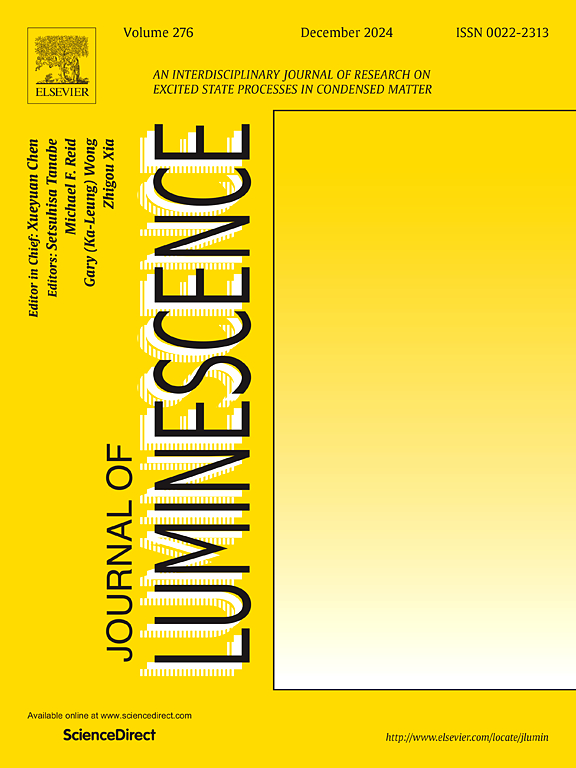Efficient near-infrared emission and imaging of lead-free double perovskite Cs2TeCl6 by Mo4+ doping
IF 3.3
3区 物理与天体物理
Q2 OPTICS
引用次数: 0
Abstract
In this work, we successfully synthesized a novel lead-free perovskite material Cs2TeCl6: xMo4+(x = 0.02,0.06,0.1,0.2) and conducted in-depth research on its near-infrared emission characteristics. The morphology of the material was characterized by X-ray diffraction (XRD) and scanning electron microscopy (SEM). The results confirmed that the synthesized Cs2TeCl6: xMo4+ exhibited excellent crystallinity and high phase purity. And it exhibits efficient luminescence performance in the near-infrared region, with a maximum emission wavelength of 900 nm and a full width at half maximum of 100 nm. The photoluminescence quantum yield (PLQY) in the near-infrared region (750–1100 nm) measured at an excitation wavelength of 450 nm is as high as 29 %. The temperature-dependent (80–480K) near-infrared PL spectra also exhibit good thermal stability at low and high temperatures. Near infrared phosphor converted LEDs (pc-LEDs) made from this material exhibit excellent stability in the range of 100 mÃ500 mA. The pc-LEDs based on Cs2TeCl6: 0.1Mo4+ material exhibit efficient near-infrared emission in the near-infrared region, demonstrating excellent performance in applications such as venous photography, night vision and drug impurity detection. In addition, the excellent performance of this material not only provides new insights for the application of perovskite materials in near-infrared luminescence, but also provides important theoretical and experimental basis for the development of new and efficient near-infrared luminescent materials.

Mo4+掺杂无铅双钙钛矿Cs2TeCl6的高效近红外发射和成像
本文成功合成了一种新型无铅钙钛矿材料Cs2TeCl6: xMo4+(x = 0.02,0.06,0.1,0.2),并对其近红外发射特性进行了深入研究。用x射线衍射仪(XRD)和扫描电镜(SEM)对材料的形貌进行了表征。结果表明,合成的Cs2TeCl6: xMo4+具有优异的结晶度和较高的相纯度。在近红外区域表现出高效的发光性能,最大发射波长为900 nm,最大半宽为100 nm。在450 nm激发波长下,近红外区(750 ~ 1100 nm)的光致发光量子产率(PLQY)高达29%。温度相关(80-480K)近红外PL光谱在低温和高温下也表现出良好的热稳定性。由该材料制成的近红外荧光粉转换led (pc- led)在100 mÃ500 mA范围内表现出优异的稳定性。基于Cs2TeCl6: 0.1Mo4+材料的pc- led在近红外区域表现出高效的近红外发射,在静脉摄影、夜视和药物杂质检测等应用中表现出优异的性能。此外,该材料的优异性能不仅为钙钛矿材料在近红外发光中的应用提供了新的见解,也为开发新型高效近红外发光材料提供了重要的理论和实验基础。
本文章由计算机程序翻译,如有差异,请以英文原文为准。
求助全文
约1分钟内获得全文
求助全文
来源期刊

Journal of Luminescence
物理-光学
CiteScore
6.70
自引率
13.90%
发文量
850
审稿时长
3.8 months
期刊介绍:
The purpose of the Journal of Luminescence is to provide a means of communication between scientists in different disciplines who share a common interest in the electronic excited states of molecular, ionic and covalent systems, whether crystalline, amorphous, or liquid.
We invite original papers and reviews on such subjects as: exciton and polariton dynamics, dynamics of localized excited states, energy and charge transport in ordered and disordered systems, radiative and non-radiative recombination, relaxation processes, vibronic interactions in electronic excited states, photochemistry in condensed systems, excited state resonance, double resonance, spin dynamics, selective excitation spectroscopy, hole burning, coherent processes in excited states, (e.g. coherent optical transients, photon echoes, transient gratings), multiphoton processes, optical bistability, photochromism, and new techniques for the study of excited states. This list is not intended to be exhaustive. Papers in the traditional areas of optical spectroscopy (absorption, MCD, luminescence, Raman scattering) are welcome. Papers on applications (phosphors, scintillators, electro- and cathodo-luminescence, radiography, bioimaging, solar energy, energy conversion, etc.) are also welcome if they present results of scientific, rather than only technological interest. However, papers containing purely theoretical results, not related to phenomena in the excited states, as well as papers using luminescence spectroscopy to perform routine analytical chemistry or biochemistry procedures, are outside the scope of the journal. Some exceptions will be possible at the discretion of the editors.
 求助内容:
求助内容: 应助结果提醒方式:
应助结果提醒方式:


